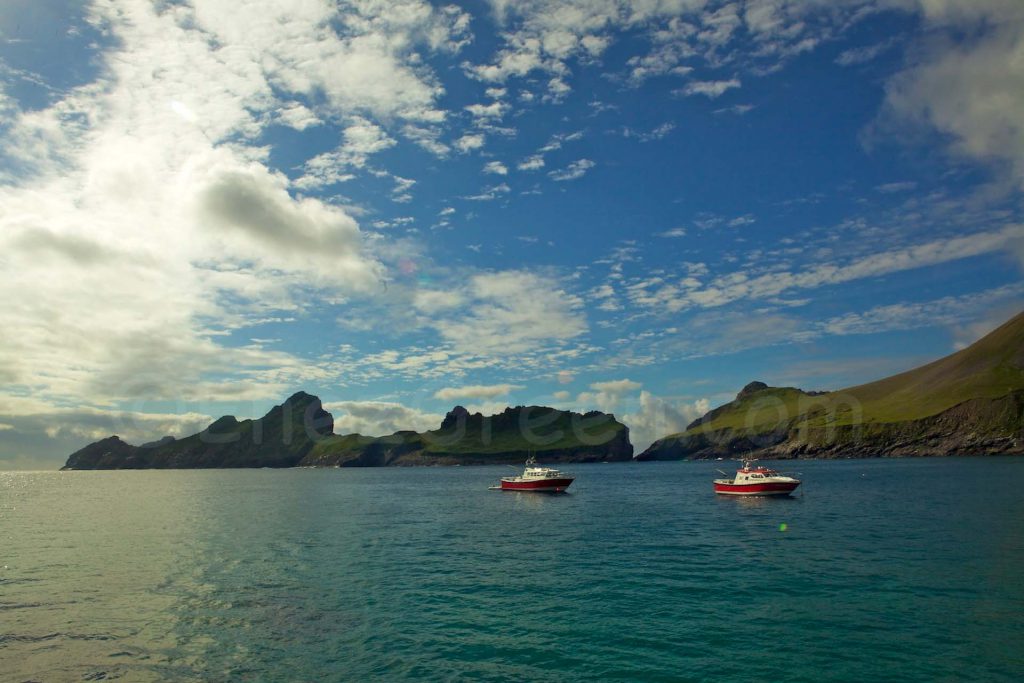A solid boat that is suited for the seas around Scotland
The St Kilda Cruises boat seems to be one of the best vessels in the Hebrides to navigate the turbulent waters on the way to St Kilda Island. This 22 tonne and 55 ft long boat immediately inspires confidence in passengers. Other companies also offer transfers to the island, but smaller boats are often used, or even sometimes, in fine weather, semi-rigid inflatable boats! It is preferable in this case to check out the weather forecast and bring along some waterproof clothing!
In spite of its remoteness, many people visit this region located in the far reaches of Scotland in summer. It is thus strongly recommended to book in advance. It should be noted that two-day reservations are required, taking into account local weather conditions. Confirmation is provided once you have arrived on Harris Island, i.e. for the next day or the day after.
The boat provides good handling on the water, and handle waves particularly well. Those who do not necessarily have sea legs should note that the return trip is almost always more comfortable than the outward journey and that the ride back is less rough as the waves hit the boat from the back.
The crossing is a unique opportunity to see cetaceans and various sea birds fishing in the area!
Discovering the geological formation of St Kilda
Shortly before reaching your destination, do not hesitate to ask the skipper, Angus, to show you the 3D map of the seabed on the on-board display unit.
The depth sounder allows you to discover in real time what is happening under the boat’s hull.
You will see an immense 55-million-year-old underwater volcano with a 6-mile diameter. At the same time, you will discover before your eyes the last parts of the crater, which rise vertically to over 400 m above the water surface – the islands and islets of St Kilda. You are about to arrive!
The islet of Boreray and the stacks: A remarkable bird sanctuary
After having discovered St Kilda Island and before getting back to the mainland, Angus makes a detour via the neighbouring island of Boreray and the stacks that surround it. These small islands that are bordered by steep cliffs that rise skywards, peaking at 384 m high in Boreray, 172 m in Stac Lee and 196 m in Stac an Armin! Standing at the foot of these vertical walls is a very special feeling.
This amazing décor is completed by hundreds of thousands of birds that nest in entire sections of these cliffs, making you feel like you landed on another planet. On some slops, the dark rocks seem immaculate due to the density of the white-plumaged fauna. Flocks of birds including Northern gannets, petrels and fulmars flutter around in every direction above your heads. You will also see wild Boreray sheep grazing on meagre meadows on steep slows. This species is a survivor of Dunface, which lived in the British Isles thousands of years ago and which disappeared save in a few places such as the Shetland and Hebrides Islands. One wonders how these animals have been able to survive for hundreds, or even thousands of years, in such an environment! It is even more astounding to learn that human beings have indeed lived in this unlikely place … in the Stone Age! During an expedition organised in 2011 by the National Trust of Scotland, which owns and manages these islands, traces of the settlement and culture were discovered on these grassy and dizzying slopes. If you were wondering how human beings managed to survive on Hirta, the main island of St Kilda, you will be even more puzzled given that Hirta appears as a summer holiday location when compared with Boreray.
The half hour that you will spend navigating in this outstanding area will definitely seem too short. The visit of the stacks on its own is well worth the trip from the mainland!



